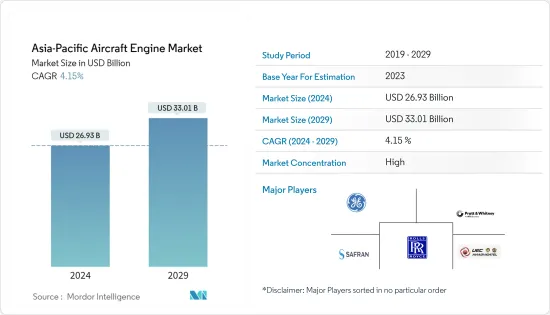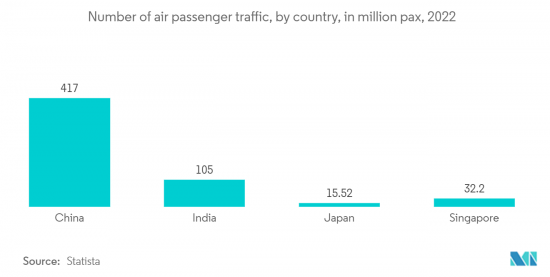PUBLISHER: Mordor Intelligence | PRODUCT CODE: 1406091

PUBLISHER: Mordor Intelligence | PRODUCT CODE: 1406091
Asia-Pacific Aircraft Engine - Market Share Analysis, Industry Trends & Statistics, Growth Forecasts 2024 - 2029

The Asia-Pacific Aircraft Engine Market size is estimated at USD 26.93 billion in 2024, and is expected to reach USD 33.01 billion by 2029, growing at a CAGR of 4.15% during the forecast period (2024-2029).
The substantial rise in passenger traffic and the imposition of new emission regulations have led to a significant increase in the demand for new-generation aircraft purchases over the last decade. Aircraft manufacturers are developing new aircraft models in commercial, military, and general aviation sectors, which require newer generation engines with better performance, low weight, better fuel efficiency, and lesser emissions. As a result, the emphasis on newer material technologies like composites is increasing.
Technological innovations are significantly fueling market growth, and the development of new models is resulting in weight reduction, less noise footprints, less emissions, high thrust, reduction in maintenance operations, etc. Hybrid propulsion commercial aircraft engines are boosted by the development of battery technology in areas such as weight reduction, less space requirement, and high power. factors such as these will be fueling the growth of aircraft engines in the Asia-Pacific
region.
Asia-Pacific Aircraft Engine Market Trends
Turbofan Engine is expected to Dominate the Market during the Forecasted Period
The turbofan segment is expected to dominate the aircraft engines market and is anticipated to dominate the market during the forecast period. Turbofan engines are most widely used in commercial and military segments. Major investments have developed the next generation of highly efficient jet engines. In most cases, these engines will be equipped with long-range aircraft that travel long distances without stopping, including intercontinental flights. For instance, in June 2021, General Electric, an aircraft engine manufacturer, and Safran unveiled plans to test-build an open-bladed jet engine that can reduce fuel use and emissions by 20%. The RISE engine, positioned as a successor to the LEAP model used on the Airbus A320neo and Boeing B737 MAX, would feature a design with visible fan blades known as open-rotor and could enter service by the mid-2030s. Air passenger traffic in the Asia-Pacific has witnessed significant improvements and growth in recent times owing to the robust vaccination programs in several countries, which has helped the governments ease air travel regulations, and this will lead to increased opportunities in terms of air travel in the Asia-Pacific region. With growing aircraft orders in the commercial aircraft segment, which is majorly dominated by the turbofan engine segment, the turbofan engine segment is anticipated to register the highest CAGR during the forecasted period.

India is Projected to Exhibit the Highest Growth Rate in the Market
India is one of the fastest-growing aviation markets globally and has significant potential for growth in the future. India is the world's fourth-largest military spender and Asia's second-largest military spender as of 2022. India is one of the fastest-growing aviation markets in the world and has a significant potential for growth in the coming years. Also, an increase in the budget allocation for improving airport infrastructure and the establishment of new airports will support the growth of the aviation sector over the next decade. Indigo is the largest airline in the country (in terms of passengers carried and fleet), and as of March 2022, the airline had a domestic market share of 59%. The business jet purchases in the country comprise mostly pre-owned aircraft as the country is an emerging economy with comparatively lower disposable incomes. This factor is currently hindering the growth of the market in the country. India has a total fleet of 253 business jets as of March 2023. Considering the developments, the passenger and defense aviation sector of the country is in a sweet spot. Thus, the demand for aircraft engines is likely to grow during the forecast period.
Asia-Pacific Aircraft Engine Industry Overview
The Asia-Pacific aircraft engine market is highly consolidated, with a majority of the market share being held by Pratt & Whitney (RTX Corporation), Rolls-Royce plc, Safran SA, UEC Aviadvigatel JSC, and General Electric Company. The engine manufacturers and aircraft OEMs often prefer long-term contracts, thereby making it difficult for new players to enter the market. The significant investment toward R&D of advanced technologies, like additive manufacturing and incorporation of AI to increase the production rate, is expected to help the players ramp up their production capacity, thereby maximizing their profits. For instance, in June 2023, India and the US are set to collaborate on the production of fighter jet engines. The deal will be signed between General Electric and Hindustan Aeronautics Limited (HAL) for the transfer of approximately 80% of the jet engine technology by value.
Additional Benefits:
- The market estimate (ME) sheet in Excel format
- 3 months of analyst support
TABLE OF CONTENTS
1 INTRODUCTION
- 1.1 Study Assumptions
- 1.2 Scope of the Study
2 RESEARCH METHODOLOGY
3 EXECUTIVE SUMMARY
4 MARKET DYNAMICS
- 4.1 Market Overview
- 4.2 Market Drivers
- 4.3 Market Restraints
- 4.4 Porter's Five Forces Analysis
- 4.4.1 Bargaining Power of Suppliers
- 4.4.2 Bargaining Power of Buyers/Consumers
- 4.4.3 Threat of New Entrants
- 4.4.4 Threat of Substitute Products
- 4.4.5 Intensity of Competitive Rivalry
5 MARKET SEGMENTATION
- 5.1 Engine Type
- 5.1.1 Turbofan
- 5.1.2 Turboprop
- 5.1.3 Turboshaft
- 5.1.4 Piston
- 5.2 End User
- 5.2.1 Commercial Aviation
- 5.2.2 Military Aviation
- 5.2.3 General Aviation
- 5.3 Country
- 5.3.1 Asia-Pacific
- 5.3.1.1 China
- 5.3.1.2 India
- 5.3.1.3 Japan
- 5.3.1.4 Singapore
- 5.3.1.5 South Korea
- 5.3.1.6 Rest of Asia-Pacific
- 5.3.1 Asia-Pacific
6 COMPETITIVE LANDSCAPE
- 6.1 Vendor Market Share
- 6.2 Company Profiles
- 6.2.1 Aero Engine Corporation Of China
- 6.2.2 JSC UEC-Aviadvigatel
- 6.2.3 Hindustan Aeronautics Limited
- 6.2.4 Tata Advanced Systems Limited (Tata Sons Private Limited)
- 6.2.5 Safran SA
- 6.2.6 Pratt and Whitney (RTX Corporation)
- 6.2.7 CFM International
- 6.2.8 Ishikawajima Harima Heavy Industries Co. Limited
- 6.2.9 Thompson Aero Seating Limited
- 6.2.10 MTU Aero Engines AG
- 6.2.11 General Electric Company
- 6.2.12 Rolls-Royce plc
7 MARKET OPPORTUNITIES AND FUTURE TRENDS




